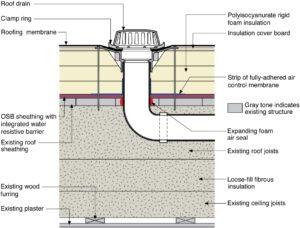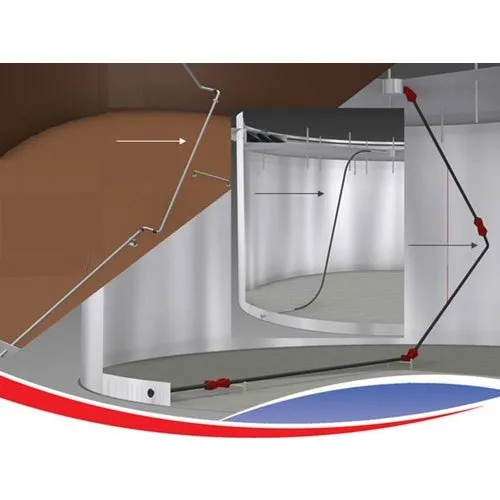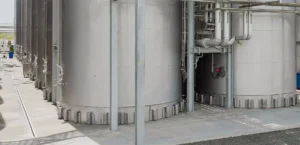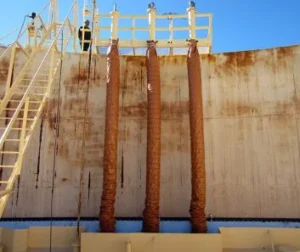As a homeowner, preventing water damage should be one of your top priorities. Rigid roof drains may seem like a minor detail but they can be the source of major headaches down the road. You’ve invested heavily in your home, so why cut corners on something as critical as your roofing and drainage system? It’s time to consider upgrading to flexible roof drains. These innovative systems are designed specifically for today’s rooftop architectures and materials. They seamlessly adapt to any surface, pitch, or configuration while maintaining optimal flow rates. Flexible drains also accommodate natural shifts and settling in the building structure over time without cracking or leaking. While the initial upfront cost may be slightly higher, flexible drains can save you thousands in repairs, replacements, and water damage in the long run. For peace of mind and to safeguard your most valuable asset, flexible roof drains should really be an industry standard.
The Problems With Rigid Roof Drainage Systems
Rigid roof drainage systems may seem straightforward, but they often come with problems that reduce effectiveness and longevity.
Clogs and Backups
Rigid pipes don’t allow for any flex or movement, so it’s easy for debris to get stuck inside and clog the system. Leaves, dirt, and other waste can accumulate over time and obstruct water flow, leading to backups that damage the roof. Flexible hoses, on the other hand, can shift to dislodge clogs and prevent major blockages.
Leaks
The joints and connections in rigid piping systems are prone to leaks over time as materials expand and contract. Sealants and caulk eventually break down, allowing water to seep in. Flexible hoses have fewer joints overall, and their elastic materials move with the roof to seal tightly and reduce leaks.
Difficult Installation
Rigid pipes can be challenging to install, requiring precise measuring, cutting, and fitting of inflexible materials. Their heavy, awkward pieces must be hoisted onto rooftops and secured in place. Flexible hoses, however, are lightweight, pliable, and much faster to install, saving time, labor, and costs. 
Limited Drainage Options
Rigid systems offer little versatility or customization in terms of pipe routing and drainage placement. They must follow a straightforward path directly from the roof to the ground. Flexible hoses, on the other hand, can be bent, twisted, and shaped to provide drainage exactly where and how you need it for optimal effectiveness.
In summary, rigid roof drainage systems often create more problems than they solve. Flexible hoses are the superior choice, offering clog-resistant, leak-proof, easy to install, and customizable solutions for effective, long-lasting roof drainage.
Why Flexibility Is Key for Effective Roof Drainage
Flexible roof drains are crucial components for effective roof drainage systems. Their adaptability provides key benefits over rigid piping.
Superior Flow Control
Flexible drains can handle fluctuations in flow volume much more effectively than rigid drains. Their corrugated construction expands and contracts to accommodate variable flow rates, preventing backups. During peak flow periods, the drains open up to allow higher volumes to pass through. When flows decrease, the drains contract to maintain optimal flow velocity and prevent sediment buildup.
Simplified Installation
Flexible drains do not require precise measurements or routing plans. They can bend and contour to navigate around obstacles, simplifying installation. Rigid drains, on the other hand, require precise cutting and joining to follow the necessary path. Flexible drains also do not require sealants or connectors, reducing opportunities for leaks or breaks. Their corrugated design simply slides over the drain outlet and is clamped into place.
Durability
High-quality flexible drains are extremely durable and long-lasting. They are resistant to chemicals, UV radiation, ozone, and extreme temperatures. Their flexible construction also withstands building settlement and seismic activity without cracking. Flexible drains typically last 20-50 years, compared to 10-15 years for most rigid drains.
Reduced Costs
When all benefits are considered, flexible roof drains can provide significant cost savings over rigid drains. Their simplified installation, lower maintenance needs, and longer lifespan reduce both upfront and ongoing costs. For effective, affordable roof drainage, flexible drains should be an industry standard.
Benefits Of Flexible Roof Drains
Flexible roof drains offer several advantages over traditional rigid pipe systems. Their pliable design allows for easy installation and maintenance, as well as superior performance.
Simple installation
Flexible drains do not require precise measurements, welding or soldering to connect sections. Installers can easily contour the piping to match the shape of the roof. This simplifies the installation process and reduces labor costs.
Easy maintenance
If repairs or modifications become necessary, flexible drains are much easier to access and manipulate. Sections can be detached and reattached without difficulty. Rigid pipes often require cutting to access connections and then re-welding or soldering to reassemble.
Superior flow
The smooth interior of flexible piping and its ability to contour with the roof create an unimpeded flow path for water. This helps prevent clogs, backups and pooling that can occur with rigid right-angle connections. Unobstructed flow also allows for faster water evacuation during heavy rains.
Durability
High-quality flexible drains are extremely durable and long-lasting. Materials like PVC, polyethylene and rubber offer weather, chemical, and UV resistance to withstand exposure to extreme heat, cold, and sunlight without cracking or breaking down over time. Some types can last 20-50 years or more.
Versatility
Flexible drains come in a variety of diameters to suit different roof sizes and water flow volumes. They are also compatible with all standard rigid pipe connection components like elbows, tees, couplings and adapters for easy integration into existing plumbing systems. This versatility makes them ideal for residential and commercial roof drainage Solutions applications.
In summary, flexible roof drains provide an efficient, cost-effective solution for channeling water away from rooftops. Their simple installation, low maintenance, superior performance, durability and versatility offer compelling benefits over rigid pipe alternatives. For these reasons, flexible drains should be considered an essential standard component of any roof plumbing system.
Conclusion
As a homeowner or property manager, you owe it to yourself to consider flexible roof drain systems for your next roof installation or repair. While traditional rigid piping has its place, the benefits of flexible hosing are too significant to ignore. Avoiding costly damage from clogs, leaks, and burst pipes will provide peace of mind and ensure maximum roof lifespan. Flexible systems are also far easier to install and maintain, saving you time, money and hassle. For worry-free, high-performance drainage that will keep your roof in peak condition for decades, flexible roof drains are the clear choice. Make them standard for your next roofing project and enjoy the many returns on that investment for years to come.




